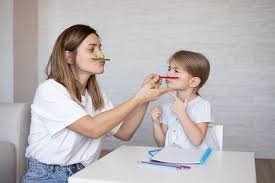
In today’s world, many children face challenges in communication, motor skills, behavior, and daily routines. Whether it’s difficulty forming words, holding a pencil, or staying focused in school, early support can make all the difference. That’s where speech and occupational therapy come in — two powerful therapies that help children grow, learn, and thrive.
Let’s explore what these therapies are, how they work, and why they’re so important for a child’s overall development.
What Is Speech Therapy?
Speech therapy focuses on helping children communicate more effectively. A licensed speech-language pathologist (SLP) works with kids to improve:
Speech sounds (pronunciation and clarity)
Language skills (understanding and using words)
Social communication (like making eye contact or taking turns)
Stuttering and fluency
Feeding and swallowing (especially in younger children)
Speech therapy helps children express themselves, understand others, and engage more confidently with the world around them.
What Is Occupational Therapy?
Occupational therapy (OT) helps children develop the physical, sensory, and cognitive skills they need to perform daily activities. An occupational therapist works on areas like:
Fine motor skills (grasping objects, writing, using scissors)
Gross motor skills (balance, coordination, body strength)
Sensory processing (responding appropriately to touch, sound, or movement)
Daily life skills (dressing, brushing teeth, feeding)
Attention and self-regulation (staying focused, managing emotions)
OT empowers children to be more independent and capable in everyday life.
When Is Speech or Occupational Therapy Needed?
Every child develops at their own pace, but some signs may indicate a need for extra support:
Speech Therapy Might Be Needed If Your Child:
Isn’t speaking as much as expected for their age
Has trouble being understood by others
Struggles to follow directions or answer questions
Doesn’t make eye contact or engage in conversations
Has difficulty eating, chewing, or swallowing
Occupational Therapy Might Be Needed If Your Child:
Has trouble holding a pencil, spoon, or toys
Avoids certain textures or is overly sensitive to touch or sound
Struggles with balance, coordination, or strength
Finds it hard to stay focused or calm
Has difficulty with dressing, hygiene, or other self-care tasks
How Do Speech and Occupational Therapy Work Together?
While speech and occupational therapy address different areas, they often go hand in hand—especially for children with multiple developmental delays or conditions like autism, ADHD, or sensory processing disorder.
For example:
A child with sensory issues (addressed in OT) may also struggle with speech because they’re overwhelmed by sound.
A child who struggles with fine motor skills (OT) may also have trouble with the mouth muscles needed for speech (SLP).
Working together, both therapists can create a more comprehensive treatment plan that supports the whole child.
What to Expect During Therapy
Therapy sessions are child-friendly, hands-on, and based on play. Kids may work one-on-one with a therapist or in small groups. Activities are designed to be fun while building critical skills.
Therapists also involve parents by sharing strategies and exercises to continue at home, so progress continues outside the therapy room.
Benefits of Speech and Occupational Therapy
Improved communication and language skills
Better fine and gross motor coordination
Increased independence in daily tasks
Enhanced self-esteem and social skills
Greater success in school and at home
Final Thoughts
Speech and occupational therapy are more than just treatment plans — they’re stepping stones toward confidence, independence, and growth. Early intervention can set children up for long-term success, and even small improvements can lead to big breakthroughs over time.

